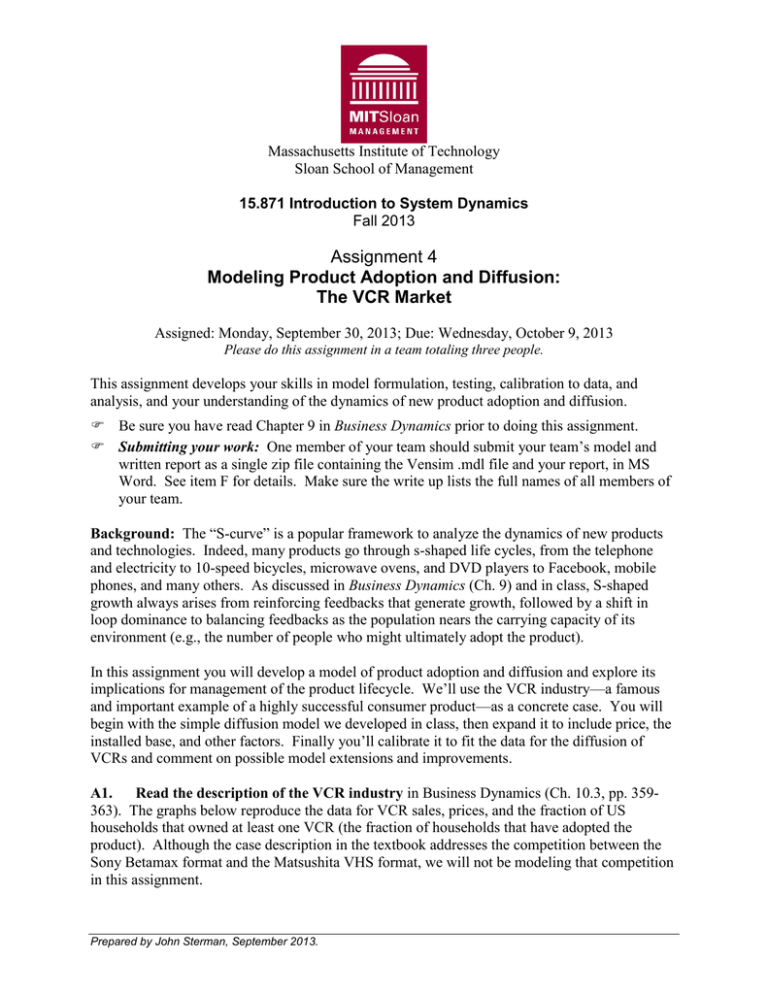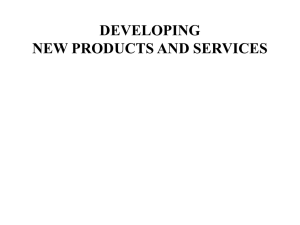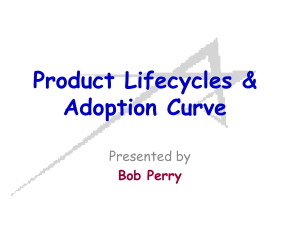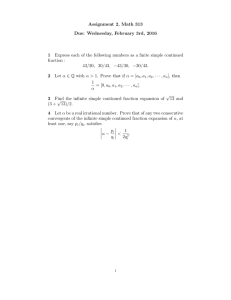Assignment 4 Modeling Product Adoption and Diffusion: The VCR Market
advertisement

Massachusetts Institute of Technology Sloan School of Management 15.871 Introduction to System Dynamics Fall 2013 Assignment 4 Modeling Product Adoption and Diffusion: The VCR Market Assigned: Monday, September 30, 2013; Due: Wednesday, October 9, 2013 Please do this assignment in a team totaling three people. This assignment develops your skills in model formulation, testing, calibration to data, and analysis, and your understanding of the dynamics of new product adoption and diffusion. Be sure you have read Chapter 9 in Business Dynamics prior to doing this assignment. Submitting your work: One member of your team should submit your team’s model and written report as a single zip file containing the Vensim .mdl file and your report, in MS Word. See item F for details. Make sure the write up lists the full names of all members of your team. Background: The “S-curve” is a popular framework to analyze the dynamics of new products and technologies. Indeed, many products go through s-shaped life cycles, from the telephone and electricity to 10-speed bicycles, microwave ovens, and DVD players to Facebook, mobile phones, and many others. As discussed in Business Dynamics (Ch. 9) and in class, S-shaped growth always arises from reinforcing feedbacks that generate growth, followed by a shift in loop dominance to balancing feedbacks as the population nears the carrying capacity of its environment (e.g., the number of people who might ultimately adopt the product). In this assignment you will develop a model of product adoption and diffusion and explore its implications for management of the product lifecycle. We’ll use the VCR industry—a famous and important example of a highly successful consumer product—as a concrete case. You will begin with the simple diffusion model we developed in class, then expand it to include price, the installed base, and other factors. Finally you’ll calibrate it to fit the data for the diffusion of VCRs and comment on possible model extensions and improvements. A1. Read the description of the VCR industry in Business Dynamics (Ch. 10.3, pp. 359363). The graphs below reproduce the data for VCR sales, prices, and the fraction of US households that owned at least one VCR (the fraction of households that have adopted the product). Although the case description in the textbook addresses the competition between the Sony Betamax format and the Matsushita VHS format, we will not be modeling that competition in this assignment. Prepared by John Sterman, September 2013. Total US VCR Sales Adoption Fraction: % of US Households with at least one VCR Average Price of VCRs 2 A2. Download the initial model. The model is called <VCR Industry.mdl>. Also download the file with the historic data, <VCR data.vdf>, and put it in the same folder as the model. Next, load the data: launch Vensim, click on the Control Panel icon in the top toolbar, select the Datasets tab, select the VCR data file in the left column and double click. It should now appear on the right side of the control panel dialog box. B. Exploring the model: The model consists of several Views, or model sectors: Model View Adoption Installed Base Price and Learning Curve P&L Statement Dashboard Content Potential adopters, adopters, adoption rate The installed base, purchases, product retirements Price of the product as it depends on the learning curve Profit and Loss statement for the industry Control panel with parameters and graphs of key variables The model is fully documented and dimensionally consistent, but incomplete. Your challenge is to add the structure needed to model the VCR industry. When developing a model, it is good practice to develop each sector in isolation and test it thoroughly before integrating the sectors. This is known as “partial model testing.” We have set up the model with switches so that each view (model sector) is initially unconnected to the others. You will first explore the behavior of each sector, using test inputs. After you understand how each sector works, you’ll link each sector to the others to create your full model. B1. Adoption: The adoption view consists of the Bass diffusion model, augmented to allow for: 1. Changes in the fraction of the population willing to adopt the product, and 2. Growth in the population. 3 For the purpose of modeling the adoption of VCRs, the most appropriate units for the populations of potential adopters and adopters are “households” because each household might want to purchase a VCR, not necessarily each person (a family would typically own one, even if there were multiple individuals in the household). 1. Changes in the fraction of the population willing to adopt the product: As seen in the data above, the price of VCRs fell dramatically over the product lifecycle. At nearly $2500 per unit in 1975, few households were willing or able to buy one, but at $250 per unit, most households were willing and able to do so. It is necessary to modify the standard Bass model to capture the change in the fraction of the population willing to adopt as it depends on product price (and, in principle, on features, functionality, and other attributes). To do so, we expand the Bass model to partition the total population into three non-overlapping subpopulations: Adopters, Potential Adopters, and those not willing to adopt the product: The population willing to adopt, M consists of those who have already adopted and those who would be willing to adopt if they were aware of the product and its attributes, but have not yet done so, that is, the potential adopters. All others are those not willing to adopt, N – M. The sum of these three is the total population. The lines dividing the three types of households will shift as the dynamics unfold. Specifically, the adoption process moves people from P to A. An increase in the population willing to adopt reduces the population not willing to adopt and increases the number of potential adopters (who would then gradually adopt, as determined by the effectiveness of advertising and word of mouth). Next we define the Population Willing to Adopt the product, M, as M = Fraction Willing to Adopt * Total Population N The Fraction Willing to Adopt is, in general, a function of the overall attractiveness of the product, which may depend on price, features, functionality, how many other people have it, and other social and economic attributes. Here we assume that the fraction willing to adopt the VCR depends only on price: Fraction Willing to Adopt = f(Price). 4 For simplicity, we assume a linear relationship, bounded, of course, between 0 and 1: FWA = MAX(0,MIN(1,(Reference Price-Price)/Reference Price)) Where the Reference Price is defined as the price at which the fraction willing to adopt falls to zero. The formulation generates a linear demand function in which the fraction willing to adopt falls from 100% when the price is zero to zero when the price reaches the reference. For the purpose of partial model testing, Price is determined by either an Exogenous Price, used to test the adoption structure, or by the Average Price, which is generated by the learning curve sector of the model. Next, we define Potential Adopters, P, as an auxiliary variable given by the Population Willing to Adopt the product less the number of Adopters, A: P = MAX(0, M – A). The MAX(0, *) function ensures that the population of potential adopters is always nonnegative (see below for an explanation of why this is necessary). Note that because the Adopter population is an input to the auxiliary equation for potential adopters there is an information feedback arrow from the adopter population to potential adopters in the model. Conceptually, the number of potential adopters is still a stock, but we can model it as an auxiliary variable because the total population, N is always the sum of the adopters, the potential adopters, and those who are not willing to adopt, which is the total population N less those willing to adopt, M: N = A + P + (N – M) Solving for P yields: P = M – A or P = N*FWA – A. Since FWA varies with the attractiveness of the product, it is possible that FWA could fall after most people have already adopted the product. To illustrate, consider an “extreme condition test”: Suppose the price of the product was very low, so that FWA was close to 100%, and that enough time has passed so that nearly everyone has already become an adopter (that is, A ≈ N). Now imagine that the price of the product suddenly jumps to a billion dollars per unit. The fraction willing to adopt would fall to zero and P = M - A would become negative. But of course potential adopters cannot be negative; the MAX function P = MAX(0, M – A) ensures that the model remains robust even under extreme conditions. Explore the behavior of the model for different values of the exogenous price. 5 Explore the behavior of the model if the exogenous price varies. You can easily impose a variety of test patterns for the exogenous price by using Vensim’s Override feature. To do so 1. Launch Synthesim 2. Right-click on the Exogenous Price for Testing (Control-Click for Mac users). You will see the following dialog box: You can now select a variety of test inputs for the variable, which will override the behavior specified by the equation for that variable. You can make the variable a constant with a slider, or have it follow a step, ramp, sin wave, exponential growth or decay, pulse or square wave. To mimic what happens if the price of the product falls, select the ramp option. A ramp is a linear change, beginning at a specified time and initial value, and ending at a specified time and final value. Start your ramp in 1980 at $2500/unit and have it end in 1990 at $0/unit. What happens to the Fraction Willing to Adopt? What happens to the Population Willing to Adopt and the Adopter population? Explore the response of the model to different parameters including Advertising Effectiveness, a, and the Adoption Fraction, i (the fraction of potential adopters coming into contact with an adopter who then adopt). Note that adoption from word of mouth depends on the product of the social contact rate, c, and the adoption fraction, i, so it is not necessary to vary both of them. You can leave the contact rate, c, at its base value and vary i to change the strength of the word of mouth feedback. 2. Growth in the population. Over the time horizon of the model (from the introduction of the VCR in 1975 through the mid 1990s, when DVDs took over), the number of households in the US grew from about 71 million to about 100 million, an average growth rate of about 1.6%/year. Modify the model to account for that growth. Define a new parameter called Fractional Net Population Increase Rate, and set it to .016/year (1.6%/year). Formulate an appropriate equation 6 for the Net Population Increase so that the Total Population, N, will grow at the fractional net population increase rate. Be sure to specify the units and provide appropriate documentation for the new variable, and for the revised formulation for Net Population Increase. Now explore the behavior of the model for different fractional growth rates, and different exogenous prices (hint: try prices low enough for the fraction willing to adopt to be nonnegative). When you are sure you understand how the adoption sector of the model behaves, move on to the installed base. B2. Installed Base: The installed base is the stock of VCRs in use. The stock of VCRs in use is increased by the Purchase Rate and drained by Product Retirements. Explore the equations for the installed base sector in the model and make sure you understand the formulations. Note: Product retirements are modeled as a material delay of the purchase rate, using one of the built in material delay functions in Vensim. Delays are treated in depth in Chapter 11 of Business Dynamics, but for now, note that product retirements occur after an average delay determined by the Useful Life of Product. The delay function used allows us to capture the fact that the useful life is an average, with some units retired before, and some after. Ch. 11 provides more information about the probability distribution of retirements. For the purpose of testing the installed base sector, the Purchase Rate is set to either Exogenous Purchases or the Endogenous Purchase Rate, depending on the value of the Switch for Exogenous Purchase Rate. Exogenous purchases are modeled as a stop function: Exogenous Purchases = STEP(Change in Purchase Rate, Time to Change Purchase Rate) 7 The STEP(Value, Step Time) function is zero before Step Time and Value afterwards. The STEP function is a simple and useful test input (along with the ramp, pulse, sin, and other functions). Explore the behavior of the installed base as it depends on the Useful Life of Product. B3. Price and the Learning Curve: As seen in the data plotted above, the price of VCRs fell over time, from about $2500 per unit when introduced in 1975 to just a few hundred dollars by the early 1990s. The price reductions were enabled by large reductions in unit costs. As discussed in detail in Ch. 10 of Business Dynamics, such cost reductions can arise from combinations of learning-by-doing, scale economies, and other processes. For the purpose of this assignment, we will model price as depending on cumulative production experience using a standard learning curve. For a wide range of products, unit costs fall by a certain fraction every time cumulative production experience doubles. For example, the graph below shows the learning curve for solar photovoltaics. Over the past 30 years, prices have fallen dramatically, with an average cost reduction of about 20% per doubling of cumulative experience. Today, costs are nearing “grid parity” —that is, in many places solar PV is nearly as cheap as conventional power from the grid. 2010 Source: Steven Chu, US Secretary of Energy; updated by J. Sterman from IPCC (2011) Special Report on Renewable Energy srren.ipcc-wg3.de/report/IPCC_SRREN_Full_Report.pdf The standard way to model learning curves is shown in the Price and Learning Curve view of the model. 8 For the purpose of the assignment, assume that the average price of VCRs is determined by unit costs and a (constant) markup. The core of the learning curve is the formulation for unit costs: Unit Cost = Initial Unit Cost*Effect of Experience on Cost Effect of Experience on Cost = (Cumulative Experience/Initial Experience)^Learning Curve Strength where the exponent, Learning Curve Strength, is a computed constant, ln(1 - Cost Reduction per Doubling of Experience)/ln(2) determined by the Cost Reduction per Doubling of Experience.* * For a learning curve where unit costs C fall by a fixed fraction per doubling of cumulative experience, denoted f, costs are given by C = C0(E/E0) where = the exponent Learning Curve Strength and E is cumulative experience. When E has doubled, costs have fallen by the fractional Cost Reduction per Doubling of Experience, f, so or (1 - f)C0 = C0(2E0/E0) = ln(1 - f)/ln(2) = log2(1 - f). Since f, the fractional cost reduction per doubling of experience, has a more intuitive meaning than the exponent , it is convenient to formulate in the model as a computed constant, = ln(1 - f)/ln(2) and then specify the cost reduction fraction f as a constant. 9 In the model, Production Experience (which accumulates to drive the learning curve) is set to either the endogenous purchase rate generated in the Installed Base sector of the model or an exogenous purchase rate used as a test input. The Exogenous Purchase Rate is formulated to grow exponentially at a rate you specify, from an initial value you specify. Explore the formulation for the learning curve and price, and test the formulation with different values for the Initial Exogenous Purchase Rate and Exogenous Fractional Growth Rate in Purchases. B4. Profit and Loss Statement: The model contains a simple P&L statement. Cumulative Profit is the accumulation of Net Income. Net income is Gross Profit les Fixed Costs (assumed here to be truly constant, whereas in reality General and Administrative costs, depreciation, product development costs, and other fixed costs do change over time). Gross Profit is Revenue less the Cost of Goods Sold. Revenue is determined by the Purchase Rate and Average Price; COGS is determined by the Purchase Rate and Unit Cost. This simple formulation omits a number of accounting subtleties such as when revenue is recognized, depreciation, taxes, and the structure of the firm’s balance sheet, but is adequate for our purposes. B5. Dashboard: The dashboard contains the key model parameters and graphs showing the behavior of the important variables, compared against the historical data. Using Vensim’s Synthesim mode, the dashboard allows you to explore the sensitivity of the model to parameters quickly, and to manually calibrate the model to fit the data.* C. Completing and Connecting the Model: Now that you have explored and tested the sectors of the model in isolation, it is time to complete the formulations and connect the sectors into a single, integrated model. C1. Modeling the Purchase Rate: Go to the Installed Base sector. You need to replace the exogenous formulation for the Purchase Rate with an endogenous formulation. Revise the formulation and add additional structure to the Installed Base sector to capture the following logic for the purchase rate: a. We model adoption and purchase separately. Adoption is the flow of people deciding to adopt the product for the first time (measured in households per year). The purchase rate is the flow of actual purchases (measured in units/year). Each adopter desires a certain number of units. In general, the number of units desired per adopter may vary with the attractiveness of the product, but you do not need to model this process: for the purpose of this assignment, make the desired number of units per adopter a constant equal to one even though we know that the number of VCRs people desired increased as the price fell, until many affluent households had one for every TV. Less affluent households could not afford one for every TV, and of course less affluent households have far fewer TVs per household than affluent ones. * The full, professional version of Vensim includes automated calibration, allowing modelers to use formal econometric techniques to estimate model parameters, including maximum likelihood methods, nonlinear least squares, Kalman filtering, and so on). 10 b. The total desired installed base is then given by the number of adopters and the desired number of units per adopter. c. Adopters’ purchase behavior accomplishes two goals: first, adopters replace units that are retired; second, adopters adjust the purchase rate above or below the replacement of retired units so as to bring the actual installed base up to the desired number of units. The adjustment for the installed base creates a balancing feedback that closes any gap between the desired and actual installed base of the product. It takes time for that stock adjustment to occur: having made the decision to adopt, people must decide which make and model to buy, then find the time to shop for it. The simplest way to formulate the stock adjustment process is to calculate the gap between the desired and actual installed base and assume that the gap is closed over a certain installed base adjustment time. The resulting structure will introduce a balancing feedback loop that adjusts the purchase rate to close any gap between the desired and actual installed base. Research suggests that the average time between the decision to buy and purchase was about one month (0.0833 years). Hint: See Business Dynamics section 17.2.1 for a more detailed treatment of this formulation. d. Finally, make sure your formulation for the purchase rate is robust under extreme conditions. Hint: purchases cannot be negative. Add the structure described above, making sure your model is dimensionally consistent and that every equation and parameter you add is fully documented. C2. Connecting the sectors: Now you are ready to connect the sectors into a single, integrated model. Use the equation tool to: a. change the value for the Switch for Exogenous Purchase Rate to zero so that Purchases are determined by the Endogenous Purchase Rate. b. change the value for the Switch for Exogenous Purchases to zero so that Production Experience is determined by the Purchase Rate. c. change the Switch for Exogenous Price to zero so the average price generated by the learning curve drives the Fraction Willing to Adopt. Now when you simulate your model all the feedbacks will be closed. C3. Calibrating your model: The values of key parameters in the base model have been selected based on the history of prior, analogous products and expert judgment. These parameters include the effectiveness of advertising, a, the adoption fraction, i, the strength of the learning curve, and the useful life of the product. How well does your model match the historical data for sales, price, and the fraction of households that have adopted the VCR? Using Synthesim, adjust the values of the key parameters to improve the historical fit of your model. You may find it useful to use the Dashboard view, as it contains the key parameters and graphs comparing your model to the data. 11 The table below lists the parameters you should use to calibrate the model, specifically, the parameters listed in the table below. Other parameters should be left at their base values.* Include this table in your report, listing your preferred parameter values. For your convenience a word document with the table is included with the assignment package, which you can simply copy and paste into your response document. Comment on the values of parameters you select. Are they reasonable? Do you think the parameters could have been selected on the basis of your prior knowledge or other data? Include in your report graphs of the model behavior compared against the historical data (sales, adoption fraction, and average price) using your preferred parameters. Hint: Do not spend a lot of time refining your parameter estimates. There is no point in excessive precision (many significant digits in your estimates). You will not be able to match the data perfectly because the model omits a number of feedbacks and structures present in the actual VCR industry (see part D). Parameter (Units) Advertising Effectiveness, a (1/year) Adoption Fraction, i (dimensionless) Reference Price ($/Unit) (Price at which fraction willing to adopt = 0) Useful Life of Product (years) Cost Reduction per Doubling of Experience (Dimensionless) Initial Experience (units) Your estimated value Comment Based on your calibrated simulation and your understanding of the feedback structure of the system, explain the evolution of the VCR market. Specifically, explain why the industry took off so quickly, the behavior of prices, and the determinants of sales. Why did sales grow so quickly for the first few years? Why did sales peak and fall around 1986? Why did sales recover around 1990? Link your narrative to the feedback and stock-flow structure of the industry, but your write up should be in terms a manager can understand. D. Sensitivity analysis: Starting from your calibrated model, explore the sensitivity of the behavior to the key parameters. Specifically, * Leave the other parameters at their base values when calibrating your model. Note that list of parameters to calibrate does not include the social contact rate: adoption from word of mouth depends on the product of the social contact rate, c, and adoption fraction, i, so only their product matters to the behavior of the model. Hence we leave the social contact rate fixed and estimate the adoption fraction, i. Additionally, given the initial markup of 20%, and the historical data showing the initial price of VCRs was about $2300/unit, initial unit costs are then $2300/1.2 ≈ $1900/unit. Similarly, we know that the initial adopter population was essentially zero, as was the initial installed base. 12 1. What is the impact of faster or slower adoption (controlled by the strength of the word of mouth and advertising effects) on diffusion? On Sales? On the drop in sales? On the pattern of net income? Why? Hint: consider the impact of rapid changes in demand on the firm’s ability to fill orders, on capacity, and on net income (note that in reality, unlike our simple model, the ability to fill orders, and the firm’s costs, depend on capacity, and capacity cannot be adjusted instantly). 2. What is the impact of a stronger or weaker learning curve on diffusion? Sales? The drop in sales? Net income? Why? How do the learning curve and diffusion interact? Hint: what feedback loop is closed when adoption drives purchases, which in turn drives the accumulation of experience? Your report should include a simple, high-level causal diagram of the feedback(s) connecting purchases, price, and adoption (note: not a diagram of every loop and variable in the model but a simple diagram suitable for sharing with the senior management team). 3. What is the impact of longer or shorter average product lifetimes? Why? What challenges do long product lifetimes pose for firms as their products go through their lifecycle? E. Critiquing the model: Your model expands on the classic logistic and Bass diffusion models in a variety of important ways: population growth is included, the fraction of the population willing to adopt changes as the price of the product varies, price falls with increasing learning from cumulative experience, and the purchase rate includes both first purchases and replacement purchases. And we have a (simple) income statement to assess the impact of different parameters and policies on profitability. However, all models are wrong and can be improved. 1. List the most important limitations and omissions in the model. List them in order of importance, that is, from the most to least likely to matter to the model’s ability to help you manage the product lifecycle. 2. If you had a limited budget for model improvement and data collection, what would be your top priority, and why? F. What to submit: Upload a single zip file to the class site that includes: 1. Your final model. Make sure a. Your model is dimensionally consistent. b. Your model is fully documented: provide a meaningful comment explaining every equation and parameter you add to or modify in the model. c. You change the values for the switches from 1 to 0, and enter the values of the parameters you set to calibrate the model, into the equations so that when the model is run it will generate your calibrated simulation. 2. A report, in Word, containing your responses to the questions in the items above, specifically: 13 a. Your responses to the questions in C3, including the table listing your preferred parameter values for calibration, your comments on them, and your explanation of the history of the VCR industry. b. Your responses to the questions in D (1-3). c. Your responses to the questions in E (1-2). 14 MIT OpenCourseWare http://ocw.mit.edu 15.871 Introduction to System Dynamics Fall 2013 For information about citing these materials or our Terms of Use, visit: http://ocw.mit.edu/terms.





